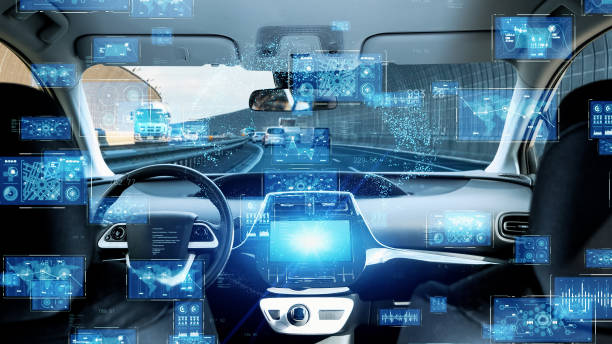Holographic Interfaces: The Future of Automotive Displays
The realm of automotive technology is on the brink of a visual revolution. As we hurtle towards an era of increasingly sophisticated vehicles, the way we interact with our cars is undergoing a dramatic transformation. Imagine a dashboard that comes alive with floating, three-dimensional displays, allowing drivers to access information and control vehicle functions with a wave of their hand. This isn't science fiction – it's the promise of holographic interfaces, poised to redefine the driving experience.

The automotive industry’s interest in holographic interfaces stems from a desire to enhance driver safety and vehicle functionality. Traditional dashboard layouts, with their myriad buttons and screens, can be distracting and cognitively demanding. Holographic displays offer a solution by presenting information in a more intuitive, three-dimensional space that aligns with the driver’s natural field of view.
How Holographic Interfaces Work in Cars
At the heart of automotive holographic technology lies a complex interplay of optics, projection systems, and advanced software. Unlike traditional displays that are confined to flat surfaces, holographic interfaces create the illusion of three-dimensional objects floating in space. This is achieved through a combination of high-resolution projectors, specialized screens or films, and sophisticated algorithms that manipulate light to create depth and dimensionality.
In automotive applications, holographic displays typically utilize a transparent screen integrated into the windshield or a dedicated area of the dashboard. Advanced projection systems behind this screen emit light patterns that, when viewed from the driver’s perspective, coalesce into coherent, three-dimensional images. Motion sensors and eye-tracking technology work in tandem with these projections, allowing drivers to interact with the holographic interface through gestures or gaze.
Benefits and Potential Applications
The advantages of holographic interfaces in vehicles extend far beyond their futuristic appeal. By presenting information in a more natural, three-dimensional format, these systems can significantly reduce the cognitive load on drivers. Critical data such as speed, navigation directions, and warning alerts can be displayed directly in the driver’s line of sight, minimizing the need to glance away from the road.
Moreover, holographic displays offer unprecedented flexibility in terms of information presentation. Unlike fixed physical gauges or screens, holographic interfaces can dynamically adjust their layout and content based on driving conditions, personal preferences, or specific vehicle functions. This adaptability allows for a more personalized and context-aware driving experience.
Potential applications of holographic technology in cars are vast and varied. Navigation systems could project three-dimensional maps and routing information directly onto the road ahead, making complex intersections and turns easier to navigate. Vehicle diagnostics could be visualized in intricate detail, allowing drivers to understand and address issues more effectively. Entertainment systems could create immersive experiences for passengers, transforming windows into interactive displays or projecting virtual landscapes.
Challenges and Limitations
While the potential of holographic interfaces in automobiles is immense, several challenges must be overcome before widespread adoption becomes feasible. One of the primary hurdles is the need for robust and reliable projection technology that can function consistently in varying light conditions and withstand the rigors of automotive use.
Image quality and visibility remain concerns, particularly in bright sunlight or adverse weather conditions. Ensuring that holographic projections remain clear and legible under all circumstances is crucial for safety and usability. Additionally, power consumption and heat generation from the projection systems pose challenges in terms of vehicle efficiency and component longevity.
Another significant consideration is the user interface design. Creating intuitive gesture controls and ensuring that drivers can interact with holographic displays without becoming distracted requires careful ergonomic planning and extensive user testing. Balancing the wealth of information that can be displayed with the need to maintain driver focus is a delicate task that will require ongoing refinement.
The Road Ahead: Integration and Innovation
As holographic technology continues to evolve, its integration into vehicles is likely to become more seamless and sophisticated. Future iterations may see the entire windshield transformed into a holographic display surface, blending augmented reality with the real world to create a truly immersive driving experience.
Advancements in artificial intelligence and machine learning will play a crucial role in enhancing the capabilities of holographic interfaces. These systems could anticipate driver needs, automatically adjusting displays based on driving patterns, environmental conditions, and even biometric data. The potential for personalization is vast, with each driver potentially having a unique holographic dashboard tailored to their preferences and habits.
The integration of holographic technology with other emerging automotive technologies, such as advanced driver assistance systems (ADAS) and vehicle-to-everything (V2X) communication, opens up new possibilities for enhancing safety and efficiency on the roads. Holographic displays could visualize complex traffic patterns, highlight potential hazards, and provide real-time feedback on vehicle performance in ways that were previously unimaginable.
As we stand on the cusp of this technological revolution, it’s clear that holographic interfaces have the potential to fundamentally change our relationship with our vehicles. By merging the digital and physical worlds in innovative ways, these systems promise to make driving safer, more intuitive, and more engaging than ever before. The road ahead for holographic displays in automobiles is bright, paved with endless possibilities for innovation and enhancement of the driving experience.





